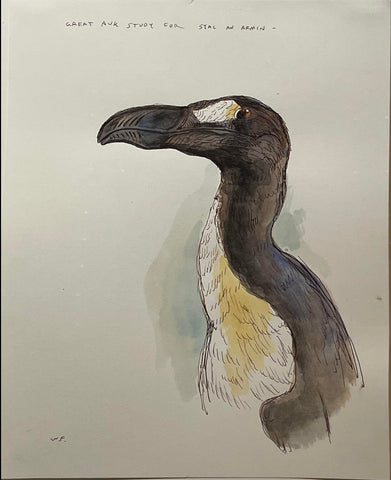Walton Ford (American, b. 1960), Great Auk Study for Stac an Armin, 2021
Walton Ford (American, b. 1960)
Great Auk Study for Stac an Armin, 2021
Watercolor, pen and ink on paper signed ‘W.P’ l.1.
Paper size: 12 x 9 in.
Frame size: 19 ¾ x 17 ¾ in.
Watercolor drawing of the head and neck of a Great Auk. This study is a preparatory drawing for the artist’s large-scale composition Stac an Armin (Gagosian Gallery).
Ford discussed the location and historical significance in Gagosian Quarterly, Spring 2022. Writing,
Fifty miles from the coast of Scotland, the rocky islands of the St Kilda archipelago bristle out of the North Atlantic like a shattered spine. Stac an Armin is one of these shards of stone. Gannets, puffins, petrels, and fulmars nest on the ledges of this volcanic spike.
In the mid-nineteenth century, the island people of St Kilda survived by eating eggs, chicks, and full-grown birds from the island’s cliffs. Travel to and from the mainland was dangerous and rarely attempted. Most islanders had never seen a tree, a horse, a painting, a staircase, or a book besides the Bible. They saw only St Kilda and her birds, storms, orcas, sharks, seals, and native sheep. Their preachers also taught them to see either God’s wrath or the devil’s hand manifested in the grim weather, disease, melancholy, and lusts engulfing them.
Around the same time, the great auk of the north Atlantic was nearing extinction. This goose-sized bird was a cousin of the puffin. A flightless bird, the great auk resembled a penguin, having evolved to do the same job—namely, to “fly” under water and catch fish. All the great auks around St Kilda had been slaughtered for their down so many years before that the islanders had no memory of them.
In July of 1840, five island men hunting birds on Stac an Armin found an auk asleep on a ledge. It was one of the last auks seen alive.
It was Malcolm McDonald who actually laid hold of the bird, and held it by the neck with his two hands, till others came up and tied its legs. It used to make a great noise, like that made by a gannet, but much louder, when shutting its mouth. It opened its mouth when any one came near it. It nearly cut the rope with its bill. A storm arose, and that, together with the size of the bird and the noise it made, caused them to think it was a witch. It was killed on the third day after it was caught, and McKinnon . . . was the most frightened of all the men, and advised the killing of it.
I wanted to imagine what this auk/witch would be doing in the minds of those men. What would a witches’ sabbath look like in the mind’s eye of these islanders? What insular sexual tension was made sinister by shouts from the pulpit? The young Lauchlan McKinnon, “the most frightened of all the men,” saw an unknown animal. In that animal he saw a fearsome female creature, a woman assuming animal form, a lascivious witch in league with the devil and the animal world. He saw his frenzied fears made flesh to be killed and forgotten.
Ford spoke with Vogue’s Dodie Kazanjian about his interest in this subject:
This is a great auk, which was driven to extinction. I’ve painted this bird before. They were flightless birds, relatively easy to roundup when they were nesting, doomed from the get-go. Anyhow, they were clubbed and eaten and made into down featherbeds. One of the very last ones that was seen by people was on this island, Stac an Armin, which is portrayed in the painting. It’s off the coast of Scotland, about 50 miles from the mainland, one of the most isolated places on earth.
In 1840, these fishermen who lived on this island had never been to the mainland. They were some of the most isolated people. They had never seen a horse or a carriage or gone up a flight of steps. So when these three fisherman found this auk, they captured it. They said it was making a great noise and trying to bite them. A storm blew up and they figured the auk was a witch. So they clubbed it to death. I wanted to paint a witch’s Sabbath that used only animals that these isolated, superstitious men would have had in their mind, and mix it with whatever weird sexual repression they might have had because they were highly Christian on that island. Very much the idea of damnation and sin and prone to believe things like witches. So I imagined that there was a young girl on the island that tempted them and made them think about her as a witch and maybe they were trying to kill off their own fear of that. That’s what this painting is about. The inner turmoil of these islanders and also this plight of one of the very last of these birds.
I looked at pictures of witches’ sabbaths, and many times there’s a fire in the center. So they’re not burning the bird. This is more like a bewitched hell. All the animals are dancing in the flames because they’re supernatural... This is what these men saw when they saw an unfamiliar bird. They really believed it was a witch, and I wanted to try to imagine what they would have visualized.
(Artist Walton Ford Walks with the Animals in a New Exhibition. Vogue, March 10, 2022)
or by email at loricohen@aradergalleries.
We Also Recommend











